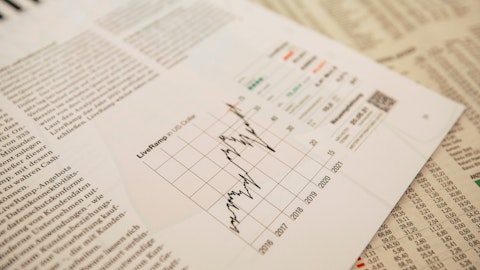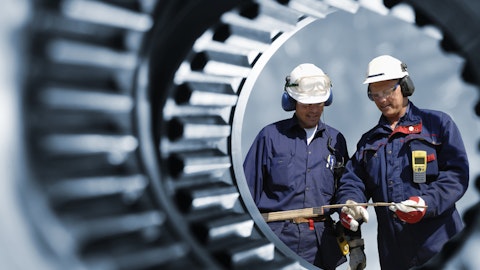Glatfelter Corporation (NYSE:GLT) Q3 2023 Earnings Call Transcript November 3, 2023
Operator: Good day, and welcome to the Glatfelter’s Q3 2023 Earnings Release Conference Call. Today’s conference is being recorded. At this time, I’d like to turn the conference over to Ramesh Shettigar. Please go ahead, sir.
Ramesh Shettigar: Thank you, Lisa. Good morning, and welcome to Glatfelter’s 2023 third quarter earnings conference call. This is Ramesh Shettigar, senior vice president, chief financial officer, and treasurer. On the call to present our third quarter results is Thomas Fahnemann, president and chief executive officer of Glatfelter; and myself. Before we begin our presentation, I have a few standard reminders. During our call this morning, we will use the term adjusted earnings, as well as other non-GAAP financial measures. A reconciliation of these financial measures to our GAAP-based results is included in today’s earnings release and in the investor slides. We will also make forward-looking statements today that are subject to risks and uncertainties.

Our 2022 form 10-K filed with the SEC and today’s release are available on our website and disclose factors that could cause our actual results to differ materially from these forward-looking statements. These statements speak only as of today, and we undertake no obligation to update them. I will now turn the call over to Thomas.
Thomas Fahnemann: Thank you, Ramesh. Hello, everyone, and welcome to Glatfelter’s third quarter conference call for 2023. I’m pleased to begin today’s call by sharing that our third quarter results improved over the second quarter. Our team took very concerted actions to address the one-time operational issues that occurred during the previous quarter, which contributed to our improved results in the third quarter. Overall, we posted adjusted EBITDA of $25.5 million for this quarter, reflecting a strong sequential recovery as our turnaround strategy continues to deliver benefits and improve earnings through operational efficiencies and organizational rightsizing. Equally important, our enterprise EBITDA margin profile is trending in a positive direction with the third quarter margin achieving the highest level in the past eight quarters.
Our third quarter performance also benefited from the accelerated sale of Ober-Schmitten, which allowed us to mitigate the site’s previously anticipated future losses and drag on our overall performance. And most notably, our segments performed well overall with composite fiber posting sequential EBITDA gains, airlaid materials achieving sequential volume growth, and spunlace delivering operational improvements and disciplined cost control. These outcomes were a direct result of important key turnaround initiatives, such as completing the broad reorganization of our Soultz, France facility; improving our Asheville, North Carolina operation; and expanding the commercial resources dedicated to increasing the profitability of our Sontara business.
See also 25 Best Places to Retire in the UK and 20 Cheapest Beach Towns to Live in the World.
Q&A Session
Follow Glatfelter Corp (NYSE:GLT)
Follow Glatfelter Corp (NYSE:GLT)
While I continue to be quite pleased with the team’s ability to deliver these important achievements, we cannot minimize the ongoing negative impacts from the difficult market conditions that have been plaguing our industry and Glatfelter business throughout all of 2023. The unsettled geopolitical situation created by the Russia, Ukraine, and Middle East conflicts continues to wreak havoc on the global economy, including overall consumer confidence, energy stability, raw material pricing, and labor inflation. For these reasons, we are lowering our annual EBITDA guidance by $10 million. This change reflects the downward pressure from the prevailing headwinds we continue to experience and anticipate for the foreseeable future. When we last issued guidance, we previously believed that market conditions and customer destocking would improve beginning with the third quarter based on market insights available at that time.
However, these improvements have been slower to materialize than originally anticipated. Despite this environment, we remain confident in the fundamentals of our business and our ability to deliver ongoing improvements that will position our business to capture the benefits from an improved market in due time. I will now turn the call over to Ramesh.
Ramesh Shettigar: Thank you, Thomas. Slide 3 of the investor presentation provides a summary of our third quarter results. Adjusted EBITDA was $25.5 million or approximately $8 million higher compared to the prior quarter. The sequential improvement was despite continued market weakness. Main drivers included benefits from turnaround actions, absence of one-time adverse items in the second quarter, and the sale of the Ober-Schmitten operations in mid-August. Airlaid materials EBITDA was lower by approximately $5 million versus a record-high quarter during the same period last year. This was mainly driven by adverse price-cost gap, lower shipments, and lower production to manage inventory levels. Composite fibers EBITDA was higher by approximately $1 million, driven by favorable price-cost gap as raw materials, energy, and freight costs declined at a faster pace than selling price and energy surcharge reductions.
Spunlace EBITDA was higher by approximately $4 million compared to the same quarter last year, driven by actions from the turnaround strategy and favorable price-cost gap. Slide 5 shows a summary of third quarter results for the airlaid materials segment. Revenues were down 8% on a constant-currency basis versus the same period last year, mainly driven by lower shipments and lower selling prices of approximately $5 million. Selling prices were lower, mainly due to cost pass-through arrangements reflecting declines in raw material costs and energy surcharges in Europe and selective price concessions to non-floating customers to preserve volume. On a net basis, the price-cost gap was unfavorable to earnings by $2.2 million. Volume was lower by 4% year over year, primarily due to weaker shipments in the feminine hygiene and tabletop categories.
This was largely driven by residual inventory destocking, market weakness in Europe, and ongoing competition from alternate substrates due to the high cost of fluff pulp. Operations were unfavorable by $1.8 million versus the prior year, primarily due to lower production to manage inventory levels and higher maintenance spending. Foreign exchange and related currency hedging positively impacted earnings by $700,000 due to strengthening of the euro. Slide 6 shows a summary of third quarter results for the composite fibers segment. Total revenues were down 20% on a constant-currency basis due to the lower shipments and lower selling prices of $2.1 million from floating prices implemented with larger food and beverage customers. The year-over-year volume decline of 11% was driven by the combination of us initiating the wind-down and subsequent divestiture of the Ober-Schmitten assets and from the softness in food and beverage, composite laminates, and metalized product categories.
Ongoing market weakness and inventory destocking also impacted some of our larger customers. The lower shipments, combined with unfavorable mix from declines in higher-margin products, negatively impacted income by $2.6 million. In addition, Ober-Schmitten results were negative $1.7 million year over year due to significantly lower volume and productivity. On a positive note, lower prices for key raw materials, energy, and freight improved earnings by $6.8 million versus the same quarter last year, reversing the negative price-cost gap trend. Operations and other was favorable by $500,000, driven by benefits from cost-out actions but were partially offset by lower production to manage inventory. Foreign exchange was unfavorable by $300,000, driven by hedging gains from last year.
Slide 7 shows a summary of third quarter results for the spunlace segment. Revenues were down 19% on a constant-currency basis, driven by lower shipments of 18% and lower selling prices of approximately $1 million coming from raw material costs pass-through provisions, primarily on the hygiene and wipe side. The volume decline was seen across all categories and negatively impacted results by $1.6 million. The three primary drivers leading up to this were general market weakness in Europe where customers traded down to cheaper imports from Turkey and China, production constraints at Sontara’s outsource converter despite stable North American demand; and unprofitable customer accounts in Soultz, France that we chose to exit. To counteract these headwinds, we rightsized our operations at this site earlier this year, reducing our workforce by 25% to improve site profitability.
And the customer rationalization from this site’s portfolio further bolstered margins. Raw material, energy, and other inflation were favorable by $4.7 million, eliminating the price-cost gap experienced for all of 2022 and into 2023. Operations, FX, and other items were $1.4 million favorable through intense focus on manufacturing efficiencies, headcount reductions, and exiting unprofitable customer relationships. Slide 8 shows corporate costs and other financial items. Corporate costs were slightly higher versus the same period last year. In the current quarter, we had a 1.2 million write-down of raw materials sold into the seconds market related to faulty material provided by a key supplier in 2022. We have filed a claim with the supplier, and we are actively working with them and their insurance carrier to recover our costs.
This negative financial impact was partially offset by benefits from the headcount reduction actions and lower professional services costs compared to the same quarter last year. Slide 9 shows our cash flow summary. In the third quarter of 2023, our adjusted free cash flow was in line with the same period last year. Cash interest was elevated by approximately $8 million related to higher interest rates. Working capital cash usage was lower by approximately $23 million, driven by raw material price declines and working capital management. Other cash flow items were unfavorable by approximately $15 million versus the same period in 2022, driven by higher prepayments and cash costs for implementing our turnaround actions. Slide 10 shows some balance sheet and liquidity metrics.
Our leverage ratio as calculated under the bank credit agreement was 3.1 times as of September 30, and we had available liquidity of approximately $185 million at quarter end. Slide 11 is a summary of our EBITDA and cash flow guidance for 2023. While our Q3 EBITDA was certainly a strong recovery from Q2, the ongoing market weakness present challenges to realizing the full potential of our turnaround initiatives. We expect this to continue into Q4, coupled with volatility and input costs, such as energy, driven by the geopolitical conflicts in Russia, Ukraine, and the Middle East. As a result, we’re lowering our full-year EBITDA guidance by $10 million. Regarding cash flow items, we expect the following: cash interest of approximately $50 million, capital expenditures to be between $30 million and $35 million.



